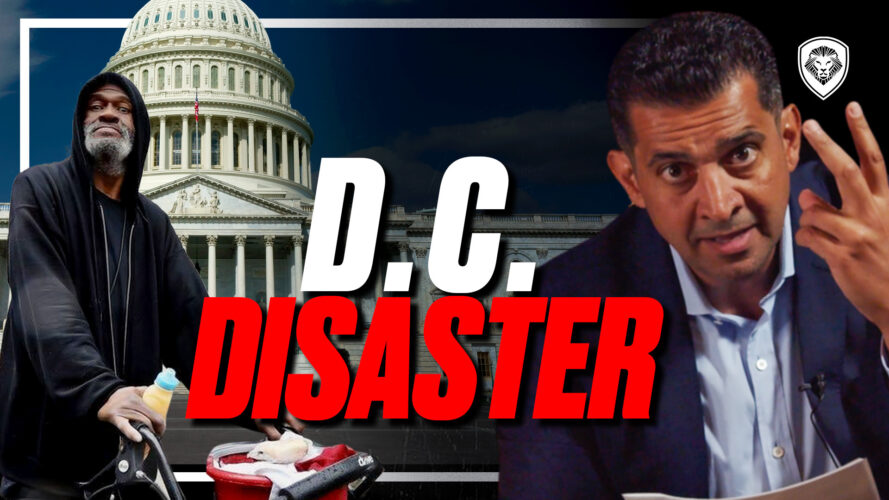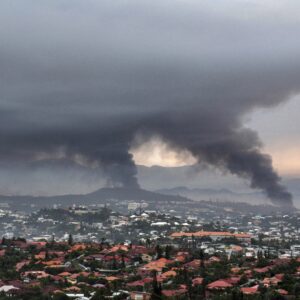Washington D.C. is a very strange city.
It ranks No. 1 in mean household income, but also ranks No. 1 in crime rate per capita. D.C. has been far above the national crime average in murder, homicide, violent crime, robberies, property crime, and larceny. That’s not all … D.C. ranks No. 1 in homelessness and has the worst graduation rate in the country at 68%.
So why is D.C. such a disaster?
All large cities experience higher levels of crime, with some worse than others depending on policy decisions. It’s unavoidable due to factors like higher populations, businesses, wealth gaps, and clustering of low-income neighborhoods.
Subscribe to PBD’s YouTube channel today for every episode LIVE or On Demand!
But why does D.C. rank among the worst in the nation in every negative category?
Policies
- The District of Columbia operates differently than the 50 states due to its unique status.
- As a federal district, its governmental powers are controlled by the United States Congress, as stated in the Constitution.
- All laws passed by the D.C. local government must undergo a 30-day review period by Congress before they can take effect. During this time, Congress can block the legislation.
- Exemplified in early 2023, the Senate blocked a criminal justice reform bill passed by D.C. local lawmakers.
- Local lawmakers are very limited with implementing policy.
Poverty
- Washington D.C. is one of the most segregated cities in the United States.
- Has a black population of nearly 45%.
- 17% of DC residents live in poverty (30% black people) – according to census bureau data.
- The federal government played a major role in perpetuating segregation in Washington D.C.
- For example The Home Owners’ Loan Corporation (HOLC) was a federal agency that was created in 1933 to help homeowners refinance their mortgages during the Great Depression.
- But the HOLC also used a racial rating system to designate certain neighborhoods as “hazardous” for lending, and these neighborhoods were disproportionately black.
Redlining and blockbusting were used heavily in Washington DC from the 1930s to the 1960s.
What is Redlining?
- Redlining was a practice by which banks and other lending institutions drew lines around neighborhoods that they considered to be high-risk for lending.
- These neighborhoods were often predominantly African American or other minority neighborhoods. As a result, people who lived in these neighborhoods were denied loans, which made it difficult for them to buy homes or start businesses.
What is Blockbusting?
- Blockbusting was a practice by which real estate agents would introduce a single African American family into a white neighborhood.
- The real estate agents would then use scare tactics to convince neighboring white homeowners to sell their homes at a loss. This would then create a panic in the neighborhood, and other white homeowners would sell their homes.
- This would lower the property values, allowing the real estate agents to buy the properties at a low price and then sell them to African Americans at a profit.
- These practices were eventually outlawed, but they heavily contributed to the concentration of poverty in black neighborhoods, and they made it difficult for black people to get good jobs and access to capital.
Crime
Unfortunately for people living in poverty, D.C. implemented very strict crime laws shortly after the decades of discriminatory practices that segregated them into low income neighborhoods.
The Firearms Control Regulations Act of 1975
- Prohibited residents from owning handguns
- Crime stats spike across the board
The Anti-Drug Abuse Act of 1986
- Created the “100-to-1” crack cocaine disparity, which meant that a person caught with crack cocaine would receive a sentence that was 100 times longer than a person caught with the same amount of powder cocaine.
- The Anti-Drug Abuse Act of 1986 led to increased arrests and jail time in Washington, D.C. The law increased the penalties for drug offenses, particularly for crack cocaine offenses, which led to an increase in the number of people arrested for drug possession and distribution.
- According to a study by the United States Conference of Mayors, the number of drug arrests in Washington, D.C. increased by 40% in the year following the passage of the ADAAA. The study also found that the number of African Americans arrested for drug offenses increased by 60% during this time period.
Other factors
- Since DC is a federal district, crimes committed in the district are subject to both federal and state law.
- More severe penalties: Federal crimes typically carry more severe penalties than state crimes. For example, the maximum sentence for drug trafficking is life in prison under federal law, but it is only 20 years under state law in many states.
- Different rules of evidence: Federal courts use different rules of evidence than state courts. This can make it more difficult for defendants to defend themselves against federal charges.
- Different procedures: Federal criminal trials are typically more complex and time-consuming than state criminal trials. This can make it more difficult for defendants to navigate the legal process.
- Washington, D.C. has a reputation for its use of harsh sentencing practices.
What does it say about the people who set policy for the entire country that the district they have the most influence over has …
- The largest wealth gap in the world
- The highest crime rate in America
- The highest rate of homelessness in America
- Bottom five unemployment in U.S.
- Bottom five High School graduation rate in U.S.
In the video, Patrick gives solutions for how to fix Washington D.C.


















Add comment